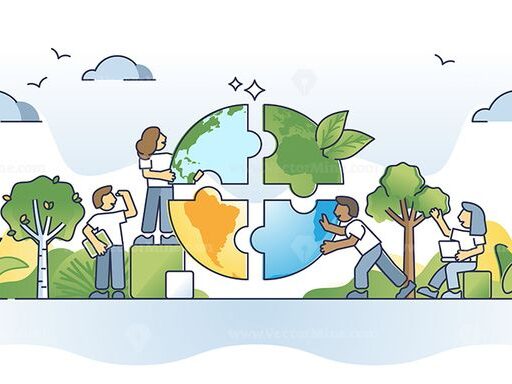An Intersectional Perspective for Environmental and Social Injustice
12 Kasım 2023Ahmet Mete Durmuş
In this paper, I will highlight the intersectionality of environmental and social injustices and offer care ethics as a vital solution to general exploitation. I will assume this exploitative worldview is caused by an anthropocentric worldview that capitalism relies on. Moreover, my purpose will be to illustrate the connection between social injustice and anthropocentrism as they share similar origins (Feygina I., 2013), and how anthropocentrism is closely related to environmental injustice because of the exploitation of nature. To create this linkage, I will benefit from Kitana Pete’s informative study which is Indigenous Environmentalism: The Rights of Manoomin (2022). The importance of this work is to show the importance social rights of Indigenous People for environmental protection, but also the illustrate the relatedness to nature as opposed to anthropocentrism. After making a connection to the roots of social injustice and anthropocentrism, I will discuss the effects of anthropocentrism on environmental injustice. To reveal, I find an alternative approach Eco-Intersectionality (Alvarez H. C.& Evans R. C., 2021), which describes a multilevel study for intersectional perspective to demonstrate the linkage between social identities and environmental crisis, as beneficial because the inclusion of data depends on scientific approach. It may reveal the lack of environmental protection among certain communities with disadvantaged social identities. Lastly, I will conclude that care ethics may be effective in breaking the roots of anthropocentrism and social injustice as they share the ideal perspectives that are dominant culture and separation from nature. For this purpose, I will criticize care ethics from the perspective of intersectionality.
Intersectional Environmentalist (IE) is a community that prioritizes the intersection of social and environmental injustices and states any thought or motion disregarding this connection may not be helpful and complete. As they indicate their purpose in their 2022 Impact Report as achieving climate justice, the path they choose to create justice is to heighten the historically disregarded voices. Because of that, IE mostly works with BIPOC, LGBTQ+, and disability-led environmental organizations around the partnership ethics that they determine. Some of their offerings include Contributor’s Network, in which works of writers, educators, researchers, etc. are submitted to IE to be served for IE communities, IE Reading List, which books are bought by IE from BIPOC, LGBTQ+, and disability-led environmental organizations and met with readers freely to support these communities and provide books to readers, or organizations such as concerts. As can be understood, IE activities are mostly built upon raising awareness about climate justice and the intersection of social and environmental injustices through education or artwork.
One of the inspirational works from the IE community is Indigenous Environmentalism: The Rights of Manoomin. In this work, Kitana Pete (2022) focuses on the case of Manoomin vs. Minnesota, which was filed because of the permission for the expansion of Line 3 to bring 3 million barrels of tar sands per day and to use 5 billion gallons of water for the tar sands. Therefore, this construction threatens water and natural sources of Northern Minnesota which Indigenous People here are heavily dependent on. Manoomin, a wild rice growing there, stands for the importance of these sources because those people have their spiritual beliefs dependent on Manoomin as well as a vital food source. Although Indigenous People constitute approximately %5 of the overall world population, the biodiversity rate they protect may reach %80 of the Earth. (Pete K., 2022) I believe these figures can be considered as powerful proofs to show the importance of environmental justice for Indigenous People to protect the environment. Manoomin is one of the indications that those people have still a feeling of connectedness to nature, which I believe is the factor that prevents an anthropocentric view. Alienation from nature is, Irina Feygina (2013) suggested, correlated with anthropocentrism, and that was so obvious that she pointed out the perception of nature is dependent on and defined as not touched by humans. This is because human nature has turned into the notion of domination from connectedness to nature and interdependence. For this reason, to me, social injustice and anthropocentrism have similar roots as well, and they share similar effects on humanity. Since the human priority over nature or non-human animals with the support from several religions or philosophies is the central opinion of anthropocentrism, nature exploitation has exacerbated over the centuries, but also in parallel social injustice.
Historically, after the development of human civilization human nature which is based on the feeling of interconnectedness with nature and interdependence with each other has shifted to the idea of materialism and alienation of human beings from both each other and nature, consequently the separation from nature and culture of domination. (Feygina I, 2013). Therefore, the separation of humanity from nature constructs the notion of domination, and the domination is culturally preserved by attitudes including support for economic growth, private property ideas, individualism, etc. (Feygina I., 2013) In that way, anthropocentrism and social injustice are linked intersectionally in the capitalist worldview giving rise to both human and nature exploitation. In addition, I argue that the effects of anthropocentrism and environmental injustice cannot be considered separated since Kitana Pete (2022) demonstrated the intersectionality of environmental injustice and the exploitation of nature. To illustrate this connection, a huge literature has focused on case studies revealing the intersectionality of environmental problems and social discrimination. (Alvarez H. C.& Evans R. C., 2021) Although these studies may be vital for the demonstration of how social identities are relevant to issues such as struggles of access to natural sources or vulnerability to environmental crisis, community-based studies rather than individual based can be offered to highlight the coming from environmental injustice.
For this purpose, Camila H. Alvarez, and Clare Rosenfeld Evans (2021) introduce the term “Eco-Intersectionality” to emphasize the importance of community-level studies instead of individually focused. In that way, they offer an alternative to case studies, so rather than considering this term as a critique of case studies, Eco-Intersectionality describes an analytical approach that covers intersectionality and environmental justice in multilevel analysis by defining demographics of communities to demonstrate the linkage of. The actual intention is to avoid misinterpretation that causes the sense that the problems covered in the case studies are exceptional, not the facts that can be applied to general. Their data shows the cancer rates across the U.S. with the demonstration of regional rates by combining them with the regional exposure to carcinogenic air toxics. The demographic variables shown by Alvarez and Evans which distribution of race/ethnic minorities among different communities, communities with the higher majority of single-mother families and lower education or lower income average demonstrate the correlation with higher cancer risks. To me, that kind of study recommended with the Eco-Intersectionality would be scientifically more effective than case studies to illustrate how the public health of minority communities is unvalued in the capitalist demands and how the view that their health is invaluable is linked to social identities.
As I connected anthropocentrism to environmental injustice, thereby social injustice because their origins which are the domination culture and alienation from nature are the same, the assumption would be clear that the prevention for anthropocentrism is to avoid the domination and to reconnect to nature and each other as well. “Nature and the human spirit have come to be seen in purely practical terms, as means to production and wealth, not as ends in and of themselves that deserve care and respect.” (Feygina I., 2013). As connectedness and interdependence are lost, anthropocentrism becomes the center of humanity, so the solution relies on reconnection to nature. While human exploitation would be prevented with the destruction of anthropocentrism, environmental injustice, and indirectly social injustice, which is connected to anthropocentrism, would be solved in most aspects or completely, because the thoughts of respect and tolerance are closely related to feelings of connectedness and relatedness. Because of that, the solution appears, to me, to be care ethics which centers respect and love for nature and the interdependence of humanity each other to its idea. Nevertheless, care ethics, if considered without intersectionality, seems impossible to solve. (Hankivsky O., 2014) Since intersectionality and care ethics have the same ideal roots including prioritizing relationships, interdependence, and strong relatedness to social justice, the integration of these two concepts seems promising. However, care ethics, which settles its ideal center on gender manifestations, especially considering some characteristics of the female gender, loses its ability to consider other aspects of oppression although concerns about racial equality are included in some manners. (Hankivsky O., 2014) Apart from the criticisms that point out that the generalization of gender characteristics is constructing a burden for genders, which Havkinsky stated, and I have the same idea, the insufficiency of including other social identities in ethnic construction comes with the idea. Still, care ethics are a reliable context to overcome anthropocentric worldviews, so environmental and social injustice since it provides the required ideas and feelings to human nature that are against the exploiter civilization we have today.
As the discussions about care ethics continue, I believe care ethics can be efficient in breaking anthropocentrism under the condition that it gains an intersectional view. With the collapse of anthropocentrism, social and environmental justice can be provided as social injustice has an anthropocentric approach, and environmental injustice is affected by anthropogenic applications. As the data shows, certain social groups need environmental protection, and the solution seems to me to care about ethics as those environmental crises that affect those people are coming from an anthropocentric perspective. The domination culture that is offered by anthropocentrism also exists in social injustice (Feygina I., 2013). This domination-based view is under the target of care ethics with intersectional perspectives. Kitana Pete also shows the effect of relatedness to nature and interdependence, which Feygina supports that modern civilization lost because of the anthropocentrism and Indigenous People still have in contrast to modern civilization, plays a vital role in the protection of nature. As Intersectional Environmentalist offers the perspective of intersectionality is crucial for those connections.

